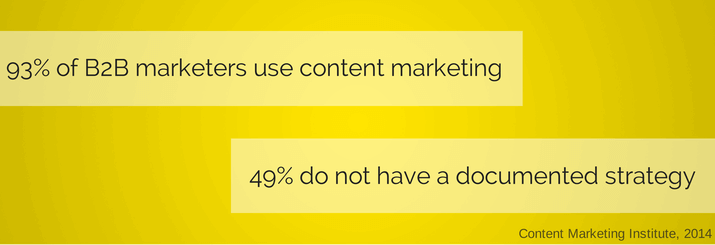Content marketing has moved from a nifty new buzzword to an established marketing strategy. It can accomplish many business and marketing goals, including:
- Increased brand recognition
- Better search quality
- Attracting new clients
- Earning positive word-of-mouth and references
- Feeding other marketing channels such as social media, direct mail, email marketing and more
- Driving traffic
Rand Fishkin of Moz summarizes it nicely in this video:
“[Content marketing makes] your website a hub, a destination beyond just the direct value that your business provides, so that you can earn referrals, word of mouth, traffic from search engines, from social media sites, from all the ways that links can be seen and shared on the web through inbound channels.”
Current situation
While so many B2B marketers understand the importance and the implementation, many are still wondering how it affects their bottom line. The most recent study by the Content Marketing Institute revealed the following:

It’s great to see the vast majority of B2B marketers are utilizing this content marketing, but what’s disappointing is so few are setting themselves up for long-term success with a documented strategy.
Oftentimes the trouble with creating a complete content marketing strategy is that it includes so many separate plans in order to be 100% effective. Different departments, budgets, buyer personas, sales cycles and tactics all play into content marketing.
In this article we’ll outline some of the most common tactics that can play a role in a holistic content marketing strategy.
Website
Content plays a critical role on a website. We’re not talking about blog posts and news updates (see more on that next), but well thought out web copy that explains your business and guides an individual through the decision making process. This means landing pages, calls to action, the navigation and more.
What you should be doing:
- Evaluate your sitemap and determine if the hierarchy is accurately explaining your business.
- Test different versions of a landing page headlines and body copy.
- Create multiple calls to action for your website using varied content.
Blogging
Often the hub for many content marketing plans, truly effective blogs are providing their audience with useful information for their business. This means listening to your current customers, finding their pain points and offering solutions.
What you should be doing:
- Researching issues and common problems in your industry to address.
- Responding to commenters (both positive and negative!).
- Repurposing blog posts for other content avenues (e.g. social media, video, eBooks, presentations, webinars, etc.) to support the sales process.
- Ensuring your website backend can handle content growth and publishing.
SEO
Content marketing and SEO are best friends. SEO loves content because it provides opportunities for effective link building. And content marketing loves SEO because it’s a measurable outcome (domain authorities, page rankings, traffic, etc.). Though quality content is at times an afterthought in SEO (and vice versa), a truly holistic and successful content marketing strategy cannot happen without SEO.
What you should be doing:
- When managing a blog, write with your SEO keywords in mind (without sounding like a robot).
- Use SEO metrics such as domain authority and linking root domains to determine guest posting opportunities.
- Measure the SEO performance of your competition such as backlinks and keyword ranking to shape future content.
Social Media
There are many opinions out there about what social media platform is right for B2B marketing. When addressing this component of your strategy determine the current performance of existing platforms, where your target audience is and your available staff to manage it.
What you should be doing:
- Curating content from third party resources, influencers, vendors and partners to share on your platforms.
- Finding influencers in your industry and engaging them with your content.
- Redistributing blog posts as “snackable” information through quotes, data points, photos or short videos.
- Exploring paid social media options when appropriate.
Email Marketing
Email marketing can play a role in every stage of the sales process, but its popularity among marketers makes it difficult to rise above the competing emails in a client’s email inbox. Similar to social media, existing content can feed your email marketing or be a standalone tactic.
What you should be doing:
- Establishing a regular newsletter schedule (weekly, monthly, quarterly) to address “top of the funnel” leads.
- Building unique email newsletter campaigns such as an educational series or special promotions geared toward stronger leads.
- Segmenting your email lists based on stages in the sales process or client demographics.
Premium Content
We like to use the umbrella term of “premium content offers” to explain the variations of a traditional white paper. This could include eBooks, one sheets, guides, FAQs, infographics, case studies, presentations and more. The unifying characteristic is they’re a digital thought leadership piece used to educate an individual on a given topic.
What you should be doing:
- Creating a variety of premium content that can address different levels of the sales process.
- Enlisting the help of a graphic designer to create visually appealing content your audience wants to read (that means a Word document won’t fly here).
- Optimizing your digital content offers for easy social media sharing.
Sales
In the end, this is the whole point of content marketing. To cast a wider net and build a more valuable list of qualified leads for a sales team. All the pieces above should receive input from the sales team.
What you should be doing:
- Updating your buyer personas based on input from sales (what attracts, resonates and sells).
- Providing sales with the tools to carry out their own content.
- Collaborating with sales to determine the best content metrics to pull.
Take Away
If you’re in the 49% of marketers without an established plan, perhaps some of the tactics listed above you’re already utilizing but it’s going undocumented. Compile all your content channels and identify a core management team that creates, distributes and measures your content.



